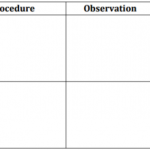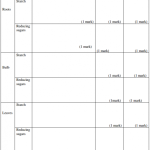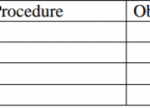KNEC KCSE Biology Paper 3 Question Paper / 2016 Pre KCSE
2016 Pre KCSE
Biology Paper 3
You are provided five with potato cylinders each measuring 5cm long, liquid S1 and S2, Hydrogen
Peroxide, dilute Hydrochloric Acid, and test tubes labeled A,B and C.
a) i) Place one cylinder in a beaker containing liquid labeled S1 and another in the liquid labeled S2.
Allow to stand for 30 minutes, then remove the cylinders, wipe them dry using blotting paper. Measure each cylinder in centimeters and record their length and texture in the table given below. (4 marks)

………………………………………………………………………………………………………………
………………………………………………………………………………………………………………
………………………………………………………………………………………………………………
………………………………………………………………………………………………………………
………………………………………………………………………………………………………………
b) Using a scalpel cut one of the cylinders into 5 parts each one centimeter long. Put the pieces into test tube A. Crush the other two using mortar and pestle into a paste. Divide the paste into two equal lots.
Put one lot into test tube B and the other into test tube C.
To each of the test tubes A and B add 2cm3 of hydrogen peroxide and to test tube C add 1 cm3 of dilute
Hydrochloric Acid, then 2cm3 of hydrogen peroxide. Record your observation below. (3marks)
Test tube A
………………………………………………………………………………………………………………
………………………………..……………………..………………………………………………………
Test tube B
………………………………………………………………………………………………………………
………………………………..……………………..………………………………………………………
Test tube C
………………………………………………………………………………………………………………
………………………………..……………………..………………………………………………………
(ii) Write a word equation for the reaction that occurs in the test tubes (1mark)
………………………………………………………………………………………………………………
………………………………..……………………..………………………………………………………
………………………………………………………………………………………………………………
(iii)Account for the rate of reaction in test tube A, B and C. (4 marks)
A
………………………………………………………………………………………………………………
………………………………..……………………..………………………………………………………
………………………………………………………………………………………………………………
B
………………………………………………………………………………………………………………
………………………………..……………………..………………………………………………………
………………………………………………………………………………………………………………
C
………………………………………………………………………………………………………………
………………………………..……………………..………………………………………………………
………………………………………………………………………………………………………………
20 marks
The diagrams below represents plants , K,L and M. study them carefully and answer the questions that follow.
SEE PHOTOGRAPHS ATTACHED
a) Giving a reason in each case, classify each plant into its division. (4 marks)
K
………………………………………………………………………………………………………………
………………………………..……………………..………………………………………………………
………………………………………………………………………………………………………………
L
………………………………………………………………………………………………………………
………………………………..……………………..………………………………………………………
………………………………………………………………………………………………………………
b) Using observable features only, state the subdivision of plant M (2marks)
………………………………………………………………………………………………………………
………………………………..……………………..………………………………………………………
………………………………………………………………………………………………………………
c) Identify the parts labeled P,U,V & Y
P
………………………………………………………………………………………………………………
U
………………………………………………………………………………………………………………
V
………………………………………………………………………………………………………………
Y
………………………………………………………………………………………………………………
d) State the functions of part T and state why (d) grows in wet areas. (2 marks)
………………………………………………………………………………………………………………
………………………………………………………………………………………………………………
20 marks
You are provided with photograph L, K and J. Examine them.
SEE PHOTOGRAPHS ATTACHED
a) Using observable features only, state class of animals shown in the photograph L and K. (4 marks)
L
………………………………………………………………………………………………………………
Reason
………………………………………………………………………………………………………………
………………………………………………………………………………………………………………
K
………………………………………………………………………………………………………………
Reason
………………………………………………………………………………………………………………
………………………………………………………………………………………………………………
b) (i) On the photograph J name the parts labeled E, F and G. (3 marks)
E
………………………………………………………………………………………………………………
F
………………………………………………………………………………………………………………
G
………………………………………………………………………………………………………………
(ii) State the functions of the structures labeled H in photograph J. (2marks)
………………………………………………………………………………………………………………
………………………………………………………………………………………………………………
………………………………………………………………………………………………………………
………………………………………………………………………………………………………………
c) (i) The actual length of animal J in cm is shown by a section of the ruler in the photograph.
Calculate the tail power (show your working)
(ii) State the significance of tail power the life of fish in water. (1mark)
………………………………………………………………………………………………………………
………………………………………………………………………………………………………………
………………………………………………………………………………………………………………
20 marks





